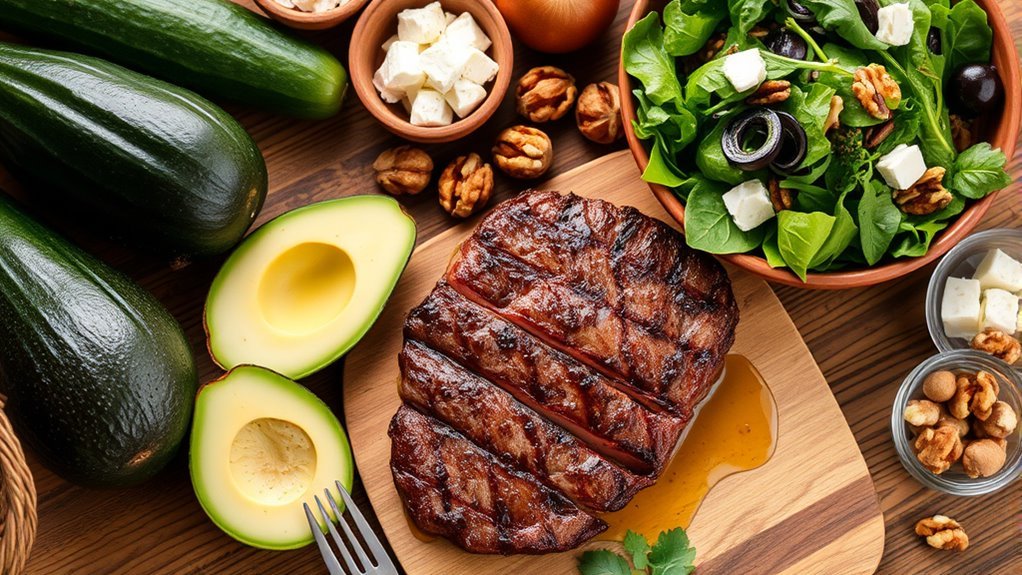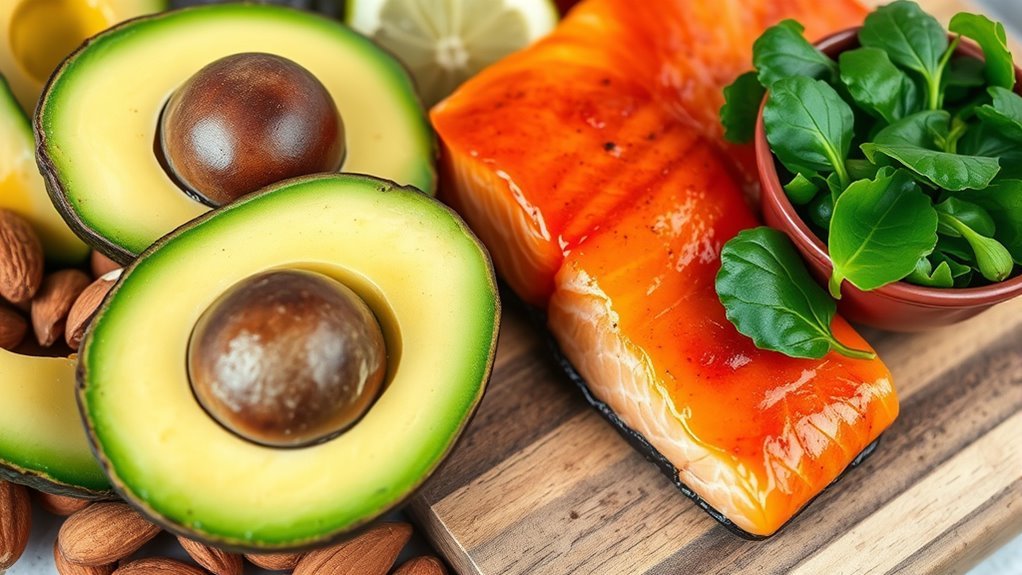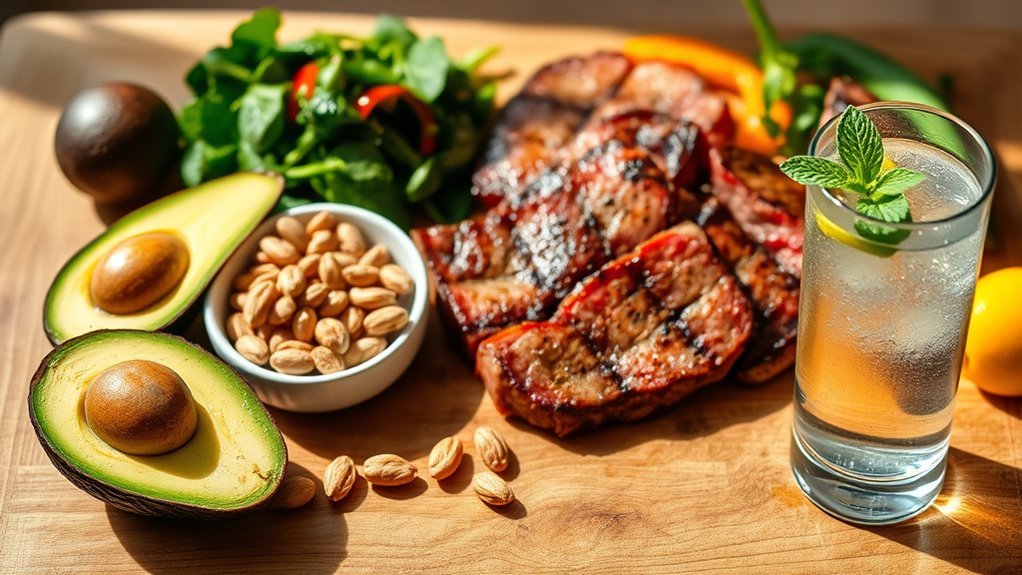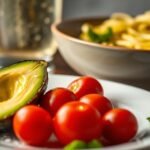A keto diet consists of a low-carb, high-fat eating plan aimed at putting your body into ketosis, where it burns fat for energy instead of carbs. You’ll typically consume about 70-75% of your calories from healthy fats, 20-25% from protein, and only 5-10% from carbohydrates, limiting your intake to 20-50 grams per day. It’s important to focus on foods like avocados, nuts, and low-carb vegetables while avoiding grains and sugars. There’s much more to discover about its benefits and challenges.
Understanding the Basics of the Keto Diet

The keto diet, short for ketogenic diet, is a low-carb, high-fat eating plan designed to shift your body’s metabolism into a state called ketosis. Understanding the keto principles is essential for achieving this metabolic state, where your body efficiently burns fat for energy instead of carbohydrates. The ketosis process involves drastically reducing carbohydrate intake, leading your body to adapt by using ketones derived from fat as its primary fuel source. This dietary adaptation can take several days to weeks and may come with initial challenges, like the “keto flu.” However, once your body adjusts, many find enhanced energy levels and weight loss benefits. Embracing these principles can give you the freedom to enjoy various foods while pursuing your health goals.
Key Macronutrient Ratios for Keto

When you’re following a keto diet, understanding the key macronutrient ratios is essential for success. Typically, you’ll aim for a high fat intake, moderate protein needs, and strict carb limitations to maintain ketosis. By balancing these elements, you can optimize your body’s fat-burning potential while ensuring you get the nutrients you need.
Ideal Fat Intake
To achieve success on a ketogenic diet, you’ll want to focus on an ideal fat intake that typically comprises about 70-75% of your total daily calories. This high percentage mainly comes from healthy fat sources, such as avocados, nuts, seeds, and olive oil. It’s crucial to choose the right fat types; prioritize unsaturated fats while limiting saturated fats and avoiding trans fats. By emphasizing quality fat sources, you’ll not only enhance your overall health but also improve your body’s ability to enter ketosis. Remember, each person’s needs can vary, so adjust your fat intake according to your activity level and individual goals. Embrace the freedom of this lifestyle while ensuring you’re fueling your body with the best fats available.
Protein Needs Explained
Achieving the right balance of macronutrients is key to the success of a ketogenic diet, and protein plays a significant role in this equation. Your protein needs depend on factors like age, weight, and activity level, but generally, it should make up about 20-25% of your daily intake.
- Focus on high-quality protein sources like grass-fed beef, wild-caught fish, and organic poultry.
- Incorporate plant-based proteins such as nuts and seeds for variety.
- Consider protein timing to optimize muscle recovery and satiety.
- Don’t overdo it—too much protein can kick you out of ketosis.
Carb Limitations Defined
Carb limitations are essential for maintaining ketosis, as they determine the body’s ability to burn fat for fuel instead of glucose. Typically, you’ll want to limit your carbohydrate intake to about 20-50 grams per day. This requires careful carb counting to guarantee you’re staying within these limits and effectively managing your glucose levels.
| Macronutrient | Daily Ratio (%) |
|---|---|
| Carbohydrates | 5-10% |
| Protein | 20-25% |
| Fat | 70-75% |
Foods to Eat on a Keto Diet

While starting on a keto diet, it’s crucial to focus on foods that align with its low-carbohydrate, high-fat principles. Incorporating the right ingredients can make meal prepping easier and more enjoyable, allowing you to indulge in keto-friendly snacks that satisfy your cravings. Here are some great options to include in your diet:
- Avocados: Packed with healthy fats and fiber.
- Eggs: A versatile protein source perfect for any meal.
- Nuts and seeds: Great for snacking and adding crunch to meals.
- Low-carb vegetables: Spinach, broccoli, and zucchini are excellent choices.
Foods to Avoid on a Keto Diet
When following a keto diet, it’s essential to steer clear of high-carb foods and sugary snacks. These items can disrupt your body’s ability to enter ketosis, where it burns fat for energy instead of carbohydrates. By understanding what to avoid, you’ll be better equipped to maintain your keto lifestyle effectively.
High-Carb Foods
To successfully adhere to a keto diet, it’s essential to steer clear of high-carb foods that can derail your progress. These foods can spike your blood sugar and kick you out of ketosis, so it’s best to avoid them altogether. Here are some common high-carb foods you should look out for:
- Sugary beverages (like sodas and fruit juices)
- Processed foods (often loaded with hidden sugars)
- Grain products (such as bread, pasta, and rice)
- Starchy vegetables (like potatoes and corn)
Sugary Snacks
Sugary snacks can be particularly tempting, but they pose a significant challenge for anyone trying to maintain a keto diet. These foods, often packed with refined sugars, can easily kick you out of ketosis, derailing your progress. Instead of reaching for traditional sweets, consider sugar alternatives like stevia or erythritol, which provide sweetness without the carbs. You can also explore snack substitutions such as nuts, cheese, or low-carb protein bars, which satisfy cravings while keeping your carb intake in check. By choosing these options, you’ll not only stay committed to your keto goals but also enjoy a variety of flavors without the guilt. Embracing these alternatives allows you freedom in your snacking while maintaining a healthy lifestyle.
Potential Benefits of Following a Keto Diet
The keto diet offers several potential benefits that can enhance your overall health and well-being. Many individuals find that, while adapting to the diet, they experience significant improvements in various aspects of their lives. Here are a few advantages you might enjoy:
The keto diet can significantly enhance your health, leading to notable improvements in various aspects of your life.
- Weight loss: Rapid fat burning can lead to effective weight management.
- Mental clarity: Ketosis may sharpen focus and improve cognitive function.
- Improved energy: Many report sustained energy levels throughout the day.
- Reduced inflammation: A ketogenic approach can lower inflammation markers.
Additionally, you may notice better digestion, appetite control, and muscle preservation due to stable blood sugar levels. While some may face the keto flu initially, these benefits often outweigh the temporary discomfort. Embracing a keto diet can truly empower your wellness journey.
Common Challenges and How to Overcome Them
While the potential benefits of a keto diet can be compelling, many individuals encounter challenges as they adjust to this new way of eating. The “keto flu,” a common hurdle, can be mitigated through proper hydration and meal prepping. Here’s a handy table to address these challenges:
| Challenge | Solution |
|---|---|
| Keto Flu | Stay hydrated; increase electrolytes |
| Cravings Management | Healthy snack ideas |
| Social Situations | Plan meals ahead |
Managing nutrient deficiencies is essential for long-term sustainability, so consider tracking your food intake. By preparing for social situations and having go-to snack ideas, you can maintain your keto lifestyle while enjoying freedom in your choices.


